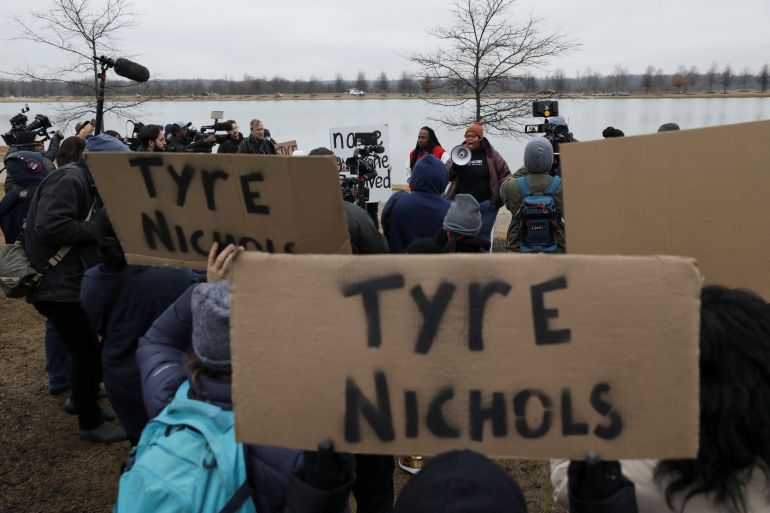Videos of police brutality can perpetuate Black trauma
The wanton display of footage of violent Black deaths re-traumatises Black communities and promotes racist tropes.

It has been two months since Tyre Nichols, a 29-year-old Black American, was brutally beaten by police officers in Memphis, Tennessee and succumbed to his injuries three days later. After the five police officers involved were arrested and charged with murder, protests over his death subsided and the media moved on.
But many of us are still reeling from seeing yet another episode of deadly anti-Black racism. Like previous violent deaths of Black people in the United States, this one was also accompanied by the release of graphic footage which was circulated widely by news outlets and on social media well beyond US borders.
The videos made their way to my UK and Ugandan WhatsApp groups – and none of them had a trigger warning. Unfortunately, some of these groups had my teenage nieces and nephews in them and I know that those videos generated palpable distress. Their parents and I, their uncle, were unable to protect them.
This reminded me of my own anguish when in 2016, a colleague shared with me without warning the video of Philando Castile being shot dead by a police officer after a traffic stop. It brought tears to my eyes and amplified the fear that both me and my partner already harboured – that as a Black man, I too could be pulled over and shot while driving alone at night. That eventually accelerated our decision to leave the US.
It is important to acknowledge that footage of anti-Black violence and police brutality has helped galvanise the public in the US and beyond to take action on deadly anti-Black racism. It has sparked protests and public campaigns to pressure the sometimes reluctant authorities to take action. Indeed, videos – whether from body cameras, surveillance equipment or mobile phones – can be a powerful tool to counter official attempts to cover up crime scenes and dodge responsibility and can constitute an important piece of evidence in court proceedings.
But the fact that American society needs to see this level of pain and suffering to begin to care tells us something about its state of affairs. To my knowledge, no other minority group has had to produce as much footage of abuse and brutality to prove that it faces a spectacular level of racism and discrimination that need to be urgently addressed.
And Black communities are forced to do so at a great cost, as the way such videos are handled is incredibly damaging to both Black Americans and Black people beyond US borders. It creates or exacerbates anxiety for many Black individuals who already suffer from intergenerational trauma. Many Black people instinctively place themselves in the position of the victim – a process which author and academic Allissa Richardson has warned can have grave repercussions.
“There has been a huge spike in suicides, among, especially, African American men and boys. You have to wonder whether it is because of this mediated violence we see now,” she says.
And there is already scientific evidence that violent footage can have a severe psychological effect on viewers. A 2017 study found that about 20 percent of people who watch graphic videos are significantly affected by them, with some individuals experiencing negative stress reactions, anxiety, and even post-traumatic stress disorder.
What is more, videos of violent Black deaths objectify the victims. They are reduced to their deaths, to Black bodies that are subjected to racist violence and abuse. And to the American and global public, they easily remain just faceless victims of racism who are stripped of their dignity and lived experiences. This effectively perpetuates the racist tropes that kill Black people.
There is a growing recognition of this dehumanisation within the Black community in the US and before the release of the brutal footage of Nichols’s death, there were attempts to counter it. Videos celebrating his life were posted on social media, some showing him enjoying skateboarding. Others spread his wonderful photography, which posthumously is also being featured at art events and on billboards across the country.
Indeed, Nichols was a talented young man, full of dreams and energy, before becoming a victim of police brutality. He should be remembered through the joyous life he chose to live, not the violent death he suffered.
As we try to overcome the pain of collectively witnessing yet another brutal death of a Black person caught on camera and circulated widely, we need to reconsider how such footage is handled in the future. Videos and images of Black people’s deaths should not be carelessly displayed and shared. The media needs to uphold ethical standards in handling such sensitive material and commit to humanising the victims, reporting on their lives and preserving their dignity.
The general public should also be made aware of the traumatising and degrading effect spreading such footage can have without care for the feelings of other Black people. We, as individuals, also hold responsibility not to perpetuate the dehumanisation of victims of police brutality and racism. We need to honour Black lives, their joy and excellence.
The views expressed in this article are the author’s own and do not necessarily reflect Al Jazeera’s editorial stance.
